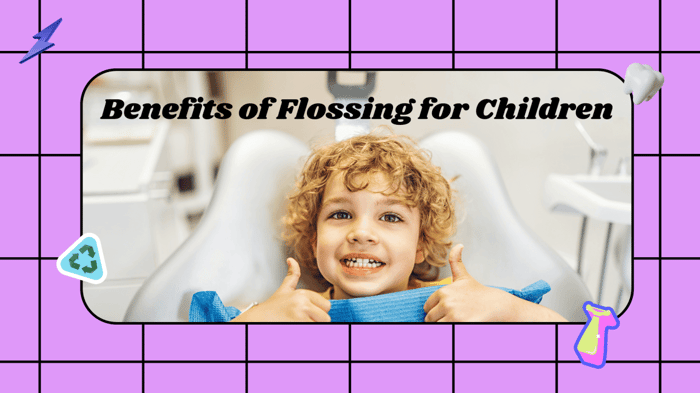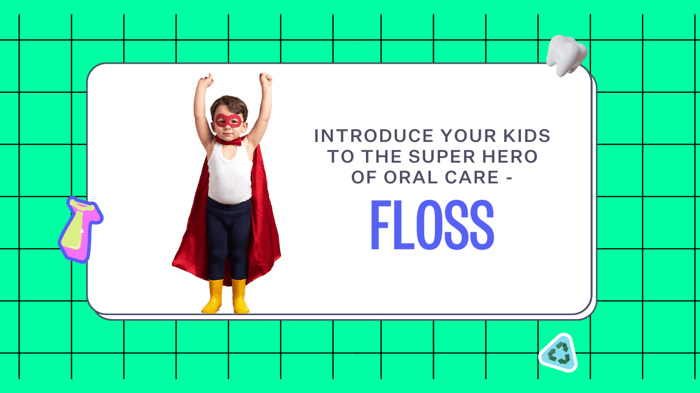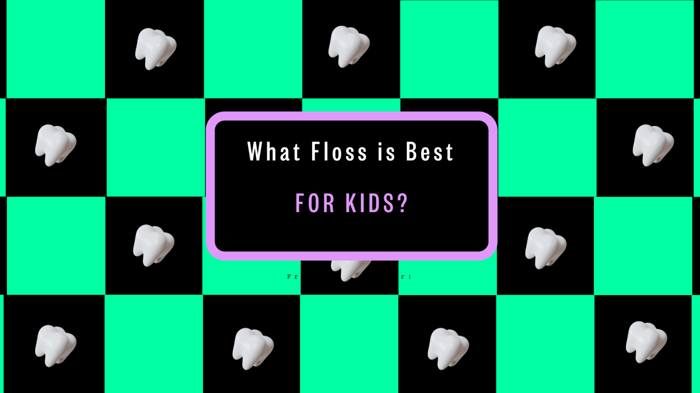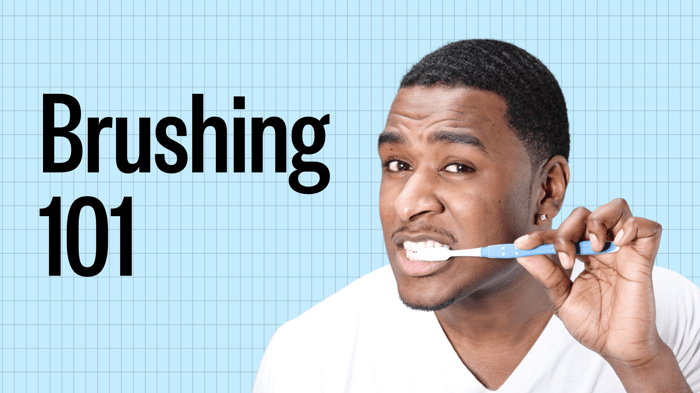You might think that children don't need to floss their baby teeth (they are going to fallout anyway, right?). But that couldn't be farther from the tooth, er, truth! The benefits of flossing for children are plentiful and flossing is a way to safeguard their oral health. Flossing assists in the removal of food bits and plaque that hide between the teeth, places where toothbrushes might not reach. In these sneaky spots, bacteria build tiny traps out of leftover foods and sugars leading to cavities and gum problems. Flossing plays detective, uncovering these hidden bacteria hangouts and disrupting plans of plaque formation, lessening chances of tooth decay. So, next time you wonder if it's necessary for your child to floss, think about those sneaky bacteria.
Flossing for children is crucial as it helps prevent cavities, reduces the risk of gum disease, and promotes good oral hygiene habits from an early age. By incorporating flossing into their routine, children can maintain healthier teeth and gums as they grow.

Importance and Benefits of Flossing for Children
Flossing might seem like a minor aspect of dental care, especially for children, but its impact is significant. It's all about cleaning those hard-to-reach places between their teeth, where food particles and plaque love to hide. You see, when children brush their teeth, they only take care of the visible surfaces, but there's a whole world in between their teeth that needs attention too. That's where flossing comes in.
When left untouched, these hidden areas can become a breeding ground for bacteria. This can lead to a multitude of dental issues such as cavities and gingivitis. Flossing not only prevents these problems from occurring but also improves overall oral hygiene. It's like giving those little teeth an extra hug, making sure they're safe and sound.
Imagine you spill some tiny beads on a fluffy rug—the vacuum cleaner won't be able to pick them up. You'll need to get down there with your hands and pick them out one by one. It's the same with flossing; it's the only way to ensure every nook and cranny is clean.
So remember, while brushing is definitely important, don't forget about the benefits of flossing for children and give those teeth a good flossing too!
Moving beyond the daily habits of dental hygiene to delve into the science behind how flossing effectively prevents cavities in children.
How Flossing Prevents Cavities in Children
When children floss their teeth, they remove tiny food particles and plaque that get stuck between their teeth. Plaque is a sticky film made of bacteria that forms on teeth, especially along the gumline. The bacteria in plaque use the sugars in food to make acid, which can wear away the enamel of the teeth and cause cavities. By regularly flossing, children can disrupt the formation of plaque, helping to prevent tooth decay and cavities.
Think of it this way: When you sweep your floors at home, you're removing dust and dirt that could otherwise gather and cause issues over time. In the same way, flossing acts as a "sweeper" for the tiny spaces between teeth, clearing out any debris that could lead to trouble later on.
The process of flossing not only removes existing plaque but also helps to prevent it from building up in the first place. As motes of food are removed during flossing, they simultaneously disrupt the environment required for bacteria to thrive. This helps lessen the chances of dental issues caused by plaque buildup.
Regular flossing disrupts the formation of plaque, thus reducing the risk of tooth decay and cavities.
Children are not able to effectively remove all traces of food particles and plaque between their teeth with brushing alone. The bristles of a toothbrush may not reach all these tight spaces, leaving some areas untouched. However, flossing is specifically designed to access these hard-to-reach places, ensuring a more thorough cleaning.
For instance, imagine trying to clean an intricate piece of jewelry with a cloth – some areas are easy to reach and clean, while others require a specific tool for thorough cleaning. In this case, floss serves as that specialized tool for reaching areas that a toothbrush can't.
By introducing regular flossing early on, parents can instill strong oral hygiene habits in their children that will benefit them throughout their lives. Not only does it contribute to preventing cavities, but it also promotes overall gum health and reduces the risk of gum disease as children grow into adulthood.
Having recognized the substantial impact of regular flossing on cavity prevention in children, let's proceed to explore the additional benefits of flossing for children related to maintaining healthy gums in children.
Building Lifelong Oral Care Practices through Flossing
Introducing children to flossing isn't just about preventing immediate issues like cavities; it's also about laying the groundwork for healthy oral habits they'll carry with them for life. By guiding them through this process early, you're giving them an invaluable skill that will serve them well into adulthood.
Ways to Make Flossing a Positive Experience
- Show children how to floss gently without hurting their gums.
- Explain that flossing helps remove food and bacteria that their toothbrush might miss, reducing the risk of cavities and gum disease.
- Take time to educate them about why flossing matters.
- Help them understand how it prevents gum disease and cavities, while also ensuring fresh breath and a bright smile.
- Lead by example - make flossing part of your daily routine for children to see.
- Make flossing fun by using flossing tools (like the Flaus Electric Flosser)
Establish a regular schedule for flossing, ideally after dinner, before bedtime or first thing in the morning. Consistency is key in forming any habit, so helping children make flossing a regular part of their day will set the stage for lifelong oral care practices.
By introducing children to the importance of flossing early on, parents are not only setting them up for strong oral health but are also investing in long-term preventive care habits that will benefit them through different stages of life—in adolescence, adulthood, and beyond.
Teaching children how to floss is much more than just a preventive measure against cavities—it's an investment in their future oral health that can create lasting habits for a lifetime.
Flossing and Its Impact on Growing Teeth
As children grow and their baby teeth make way for permanent ones, establishing good oral hygiene practices becomes even more vital. Regular flossing doesn't just ensure clean teeth and gums; it plays a crucial role in preventing overcrowding and misalignment of the teeth. When food particles and plaque accumulate between teeth, it can disrupt the natural alignment of teeth as they develop, potentially leading to overcrowding.
Removing these particles prevents harmful bacteria from flourishing, positively impacting not only the current state of the teeth but also their future growth and development. By incorporating flossing into a child's oral care routine, parents provide them with a valuable tool for maintaining healthy teeth and proper alignment, setting a strong foundation for lifelong dental health.
The removal of plaque and food particles is essential for preventing the accumulation of harmful bacteria that could potentially affect the growth and development of children's teeth. Just like tiny puzzles pieces falling perfectly into place, the regular practice of flossing assists in ensuring that each tooth has enough space to grow and be positioned appropriately within the developing jaw.
It's similar to clearing a path for a plant to grow; each tooth needs its designated space without being crowded or overtaken by neighboring teeth. Just as we weed a garden bed to allow flowers to thrive, flossing helps create a clean, healthy environment for new teeth to emerge without obstruction.
Consider how a single grain of sand can disrupt the smooth workings of a clock: similarly, accumulated plaque and food remnants may disrupt the growth process of new teeth. By teaching children early about efficient dental hygiene practices that include routine flossing, we pave the way for their continued oral health well into adulthood.
The removal of food particles and plaque through consistent flossing not only prevents bad breath but also promotes healthy gums, avoiding issues such as gum disease that can arise from poor oral hygiene habits. This emphasizes the significance of instilling flossing as an essential part of children's daily oral care routines.
As we consider these significant impacts, nurturing regular flossing habits from an early age sets the stage for optimal dental health as children's teeth continue to develop over time.
Suitable Flossing Techniques for Children
Flossing can be quite challenging for children, especially when they are just starting. It's essential to make the process as comfortable and enjoyable as possible to encourage them to build this healthy habit. Here are some suitable flossing techniques that you can use to make the experience more pleasant for your little ones.
Choosing the Right Floss: When it comes to flossing children's teeth, it's important to select the right type of floss. Waxed floss is generally smoother and slides more easily between teeth, causing less discomfort. On the other hand, unwaxed floss provides better control and removes more plaque. The choice should depend on what works best for your child, with flavored floss adding a touch of fun with flavors like mint or fruit.

Using Flossing Tools to Make the Flossing Process More Fun and Easier for Children: There is no doubt that flossing can be difficult for children. They have less dexterity in their fingers to manipulate the floss between their teeth and can't always reach the back of their mouths to reach their molars. Helping children floss is also not without it's challenges. An adult trying to help children floss is also not without difficulty - as it's hard to assist getting the floss in between their teeth and to the back of their molars. That's where tools like Flaus come in!
Flaus is an electric flosser that has up to 18,000 sonic vibrations / minute. Not only does this tool help to make flossing fun (like a new toy for flossing), it also makes it easier for kids to be able to floss themselves! This handy tool already has a piece of floss threaded through a plastic arm, making it easier for children to maneuver between their teeth without needing to struggle with managing the length and tension of traditional floss.
The long, ergonomic handle of Flaus allows for children to reach their back molars, all while being gentle on their gums and teeth. Flaus is rated for children 6+ (with supervision) and perfect for helping children become more independent in their flossing routine!
Imagine this tool as a helper that makes flossing easier and even more fun for kids to keep their teeth clean. And let's face it, getting kids excited about personal hygiene is half the battle won. Using these kid-friendly tools not only simplifies the process but also makes it less intimidating. It's like giving them training wheels on their journey to independently maintaining good oral hygiene habits.
When paired with the right technique and guidance, Flaus can help turn what seems like a daunting task into an achievable one. It's about turning a potentially difficult experience into something simple and even enjoyable.
With the right tools at our disposal, the next step is understanding techniques to ensure kids' cooperation in the flossing routine.
Role of Flossing in Overall Child Oral Health
Flossing is like gifting your child's teeth a superhero costume. It slips into the tight spaces between teeth where toothbrushes can't reach, sweeping away any hidden enemies—the plaque and food particles that cause cavities and gum disease. These small gaps between teeth become a playground for bacteria, especially when left unattended. If not removed through proper flossing, these harmful substances can lead to inflamed gums, bad breath, and cavities.
While regular brushing cleans the front and back areas of the teeth, practicing flossing targets a specific area that toothbrushes just can't reach alone. And it's this hard-to-reach area that harbors most of the trouble-causing germs and food particles.
It's similar to instilling good eating habits at a young age. Just as we encourage kids to eat their vegetables to stay healthy in the long run, emphasizing the significance of flossing becomes imperative for their overall health.
In this way, incorporating flossing as part of your child's daily dental routine can serve as an insurance policy against future dental dilemmas—they'll thank you for it down the line!
By understanding the pivotal role of flossing in maintaining children's oral health, it becomes apparent how essential it is to make flossing a fun activity for children. This approach can go a long way in cultivating positive attitudes towards dental care from an early age.
Making Flossing a Fun Activity for Children
Flossing isn't exactly what most children would call fun, but it's an essential habit for maintaining good dental health. Finding ways to make flossing enjoyable can help children develop a positive attitude towards this important routine. Let's explore some creative ways to turn this task into a playful and engaging activity.
Reward System: Children are often motivated by positive reinforcement. Implementing a reward system for consistent and thorough flossing can serve as a great incentive. Small rewards such as stickers, stars on a chart, or earning points towards a special treat after a certain number of successful flossing sessions can significantly boost their enthusiasm. It's essential to pair the reward system with education about why flossing is important. By promoting understanding alongside incentivization, children will develop valuable lifelong skills around dental hygiene.
Turning Flossing into a Game: Children love games, so incorporating elements of playfulness can make flossing feel less like an obligation. One approach is to turn flossing into a game by challenging your child to remove invisible "plaque monsters" from their teeth with each swipe of the floss. Encouraging creativity allows children to engage with the routine in an inventive and imaginative way, transforming it from monotonous to delightful.
Fun Flossing Tools: Adding flossing tools, like an electric flosser, to the mix is also a great way to encourage flossing! It allows an activity that can be challenging to be less difficult and promotes independence. Plus, it feels more like a game or flossing toy!
By infusing flossing with color, flavor, rewards, and playfulness, parents can successfully transform what might be seen as a mundane task into an enjoyable activity that cultivates healthy dental habits for life.
As parents pave the way for positive dental practices at an early age, the next consideration is determining when to initiate the flossing routine. This decision marks a crucial step in steering children towards optimal oral hygiene practices throughout their lives.
At what age should children start flossing and why?
Children should start flossing as soon as they have two teeth that touch each other, usually around the age of 2 to 3. Flossing helps prevent cavities and maintain healthy gums by removing plaque and food particles from between the teeth where toothbrushes can't reach. According to the American Dental Association, children who floss daily have a 40% lower risk of developing cavities. Starting early establishes good oral hygiene habits and promotes long-term dental health.
How often should children floss?
Children should floss once a day to maintain healthy gums and prevent cavities. According to a study by the American Academy of Pediatrics, daily flossing reduces the risk of developing cavities by 40% in children aged 6-12.
What specific benefits does flossing have on children's oral health compared to just brushing?
Flossing plays a crucial role in maintaining children's oral health by reaching areas that brushing alone cannot effectively clean. While brushing removes plaque from the surface of teeth, flossing helps remove debris and plaque between teeth and along the gumline, preventing cavities and gum disease. According to a study by the American Dental Association, children who floss daily have a 40% lower risk of developing cavities compared to those who only brush. Thus, incorporating regular flossing into children's oral hygiene routine is essential for promoting healthy gums and preventing dental problems.
Are there any potential risks or downsides to flossing for children?
While flossing is generally safe and beneficial for children, there are a few potential risks or downsides to consider. One risk is accidental gum injury if flossing is not done correctly or under adult supervision. Additionally, children with braces or dental appliances may find it more challenging to floss properly. However, these risks can be mitigated by providing proper guidance and supervision during flossing. According to a study by the American Academy of Pediatrics, when taught and supervised by parents, children as young as 6 years old can effectively floss without any significant risks.
🌟 Discover a Revolution in Oral Care! 🌟 Tired of traditional flossing? Experience the future with the Flaus Electric Flosser. ✨ Faster. Efficient. Effortless. ✨ Don't just read about it, make the switch today! 👉 Get Your Flaus Electric Flosser Starter Kit Now! 👈


















